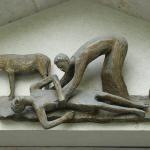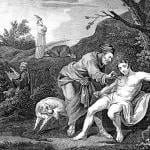I’ve always thought of the devil of the Garden of Eden as a snake like I could see today – small, cunning, wheedling. Adam and Eve I imagined to be beguiled, talked into eating that apple the same way a used car salesman talks you into buying a lemon.
Then this morning I read a post by Pascal-Emmanuel Gobry, and all of that got turned on its head.
There are traditions, he noted, in which the serpent in the garden is not small, snake-like, and whispering lies. He’s very much a fearsome dragon, before he is cursed into legless mortification. He oppresses, threatens, and intimidates. Eve trembled in fear at his awesomeness rather than being simply seduced into disobedience as she bit into the fruit, hoping to avoid pain and even the unknown-until-now death.
The failure of Adam, then, is not merely that he is morally weak and easily persuaded. His failure lies in his spinelessness, his cringing, his disobedience, and his refusal to protect not just his wife; but all of creation. The very same creation which had been designed for and entrusted to him by God, Adam wasn’t willing to chance his health and safety to defend.
In this tradition, Adam failed in the most basic task which had been given to him, to care for the gifts he had been given. It’s easy to skip past that part and rush on to the nakedness and the avenging angel, and yet in that truth lies his failure. Adam hadn’t been called to be a father figure correcting Eve’s error, but to be a heroic figure willing to give everything, even his own life, in defense of all that is good. He had only to protect and defend, follow the rules God had placed upon him, and to care for all that had been given to him. This other tradition makes so much sense to me in light of what we know comes later in the story of mankind.
I have often heard Jesus referred to as “The New Adam”. This always made sense to me in that creation began anew with Him. But, for me at least, the dragon-like snake completes the circle. In this other tradition, Christ steps into the role, not simply as the sacrificial victim he certainly was, but also as the hero Adam refused to be. He is the giant of courage to Adam’s cowardice. Where Adam cringes in the face of intimidation and loses paradise because of it, Jesus walks defiantly in the presence of that same evil when He meets it in a garden.
For me, it took the idea of the serpent as an oppressive and threatening force in order to see the image of Christ, not simply as a lamb heading willingly and obediently to slaughter, but as the defiant hero. It is in contrast to Adam’s weakness that He stands tall. It is then that his slow walk down the Via Dolarosa becomes the triumphant march of a warrior assured of victory, and through His defense that Paradise is restored to us.











